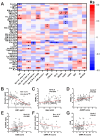Biochemical, Hematological, Inflammatory, and Gut Permeability Biomarkers in Patients with Alcohol Withdrawal Syndrome with and without Delirium Tremens
- PMID: 38792318
- PMCID: PMC11121978
- DOI: 10.3390/jcm13102776
Biochemical, Hematological, Inflammatory, and Gut Permeability Biomarkers in Patients with Alcohol Withdrawal Syndrome with and without Delirium Tremens
Abstract
Background: Delirium Tremens (DT) is known to be a serious complication of alcohol withdrawal syndrome (AWS). Neurotransmitter abnormalities, inflammation, and increased permeability are associated with the pathogenesis of AWS and DT. However, the biomarkers of these conditions are still poorly understood. Methods: In this work, biochemical, hematologic, inflammatory, and gut permeability biomarkers were investigated in the following three groups: healthy controls (n = 75), severe AWS patients with DT (n = 28), and mild/moderate AWS without DT (n = 97). Blood sampling was performed after resolution of the acute condition (on 5 ± 1 day after admission) to collect clinical information from patients and to investigate associations with clinical scales. Biomarker analysis was performed using automated analyzers and ELISA. Inflammatory biomarkers included the erythrocyte sedimentation rate (ESR), high-sensitivity C-reactive protein (hsCRP), and platelet-to-lymphocyte ratio (PLR). Results: Among the biochemical biomarkers, only glucose, total cholesterol, and alanine aminotransferase (ALT) changed significantly in the analyzed groups. A multiple regression analysis showed that age and ALT were independent predictors of the CIWA-Ar score. Hematologic biomarker analysis showed an increased white blood cell count, and the elevated size and greater size variability of red blood cells and platelets (MCV, RDWc, and PDWc) in two groups of patients. Gut permeability biomarkers (FABP2, LBP, and zonulin) did not change, but were associated with comorbid pathologies (alcohol liver disease and pancreatitis). The increase in inflammatory biomarkers (ESR and PLR) was more evident in AWS patients with DT. Cluster analysis confirmed the existence of a subgroup of patients with evidence of high inflammation, and such a subgroup was more frequent in DT patients. Conclusions: These findings contribute to the understanding of biomarker variability in AWS patients with and without DT and support the heterogeneity of patients by the level of inflammation.
Keywords: Delirium Tremens; FABP2; LBP; alcohol use disorder; alcohol withdrawal syndrome; biochemical test; blood test; gut permeability; inflammation; zonulin.
Conflict of interest statement
The authors declare no conflicts of interest.
Figures




References
-
- World Health Organization . Global Status Report on Alcohol and Health 2018. World Health Organization; Geneva, Switzerland: 2018.
-
- Bryazka D., Reitsma M.B., Griswold M.G., Abate K.H., Abbafati C., Abbasi-Kangevari M., Abbasi-Kangevari Z., Abdoli A., Abdollahi M., Abdullah A.Y.M., et al. Population-Level Risks of Alcohol Consumption by Amount, Geography, Age, Sex, and Year: A Systematic Analysis for the Global Burden of Disease Study 2020. Lancet. 2022;400:185–235. doi: 10.1016/S0140-6736(22)00847-9. - DOI - PMC - PubMed
-
- Glantz M.D., Bharat C., Degenhardt L., Sampson N.A., Scott K.M., Lim C.C.W., Al-Hamzawi A., Alonso J., Andrade L.H., Cardoso G., et al. The Epidemiology of Alcohol Use Disorders Cross-Nationally: Findings from the World Mental Health Surveys. Addict. Behav. 2020;102:106128. doi: 10.1016/j.addbeh.2019.106128. - DOI - PMC - PubMed
Grants and funding
LinkOut - more resources
Full Text Sources
Research Materials
Miscellaneous

